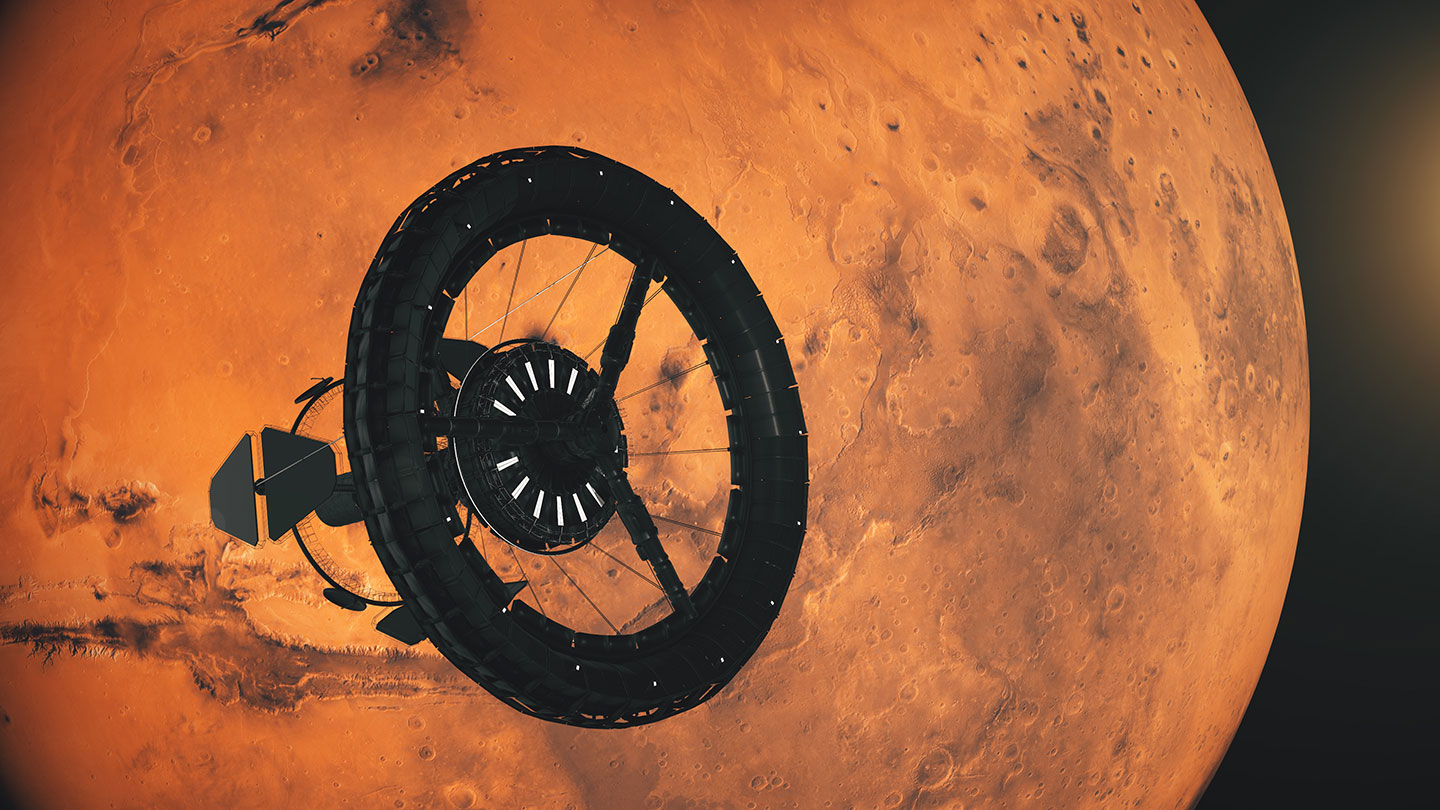Explained: SpaceX New Plan To Create Space-Based Artificial Gravity

Monday, October 25, 2021 | Chimniii Desk
Key Points
Elon Musk aims to change this with his Starship project, which will transport travellers into deep space for extended periods of time. " YouTuber'smallstars' has proposed the Gravity Link Starship (GLS), a variant of SpaceX's Starship capable of producing its own artificial gravity. "It would be sandwiched between two passenger starships and would communicate with them throughout the six-and-a-half-month journey to Mars. Smallstars is now developing the second iteration of this concept, which includes revised rotation calculations, a new truss design, and the addition of cables to increase the tensile strength of the truss. The Starship's systems are expected to be powered by solar panels, which are far more effective in space.
Advertisement

To continue the concept of SpaceX's gradual transformation of science fiction into science fact, a number of SpaceX engineers have advocated artificial gravity. Yes, that is precisely what we see in Star Trek and The Expanse, and it may be a requirement for the Starship. How is SpaceX going to accomplish this? Are they capable of doing so? You will find out in a moment.
We've all seen science fiction films in which a party of courageous astronauts is launched into space aboard a spaceship. After departing from Earth's atmosphere, the crew sets sail towards the moon, Mars, or another region of deep space. This is an ancient narrative in terms of science fiction.
This has been demonstrated in a plethora of different science fiction films, and it's tough to recollect an example off hand. The crew is constantly wandering alongside their spaceship or space station, much like they would on Earth.
But hold on a second, how is that really possible? Isn't gravity weaker in space than it is on Earth? That is correct. Once in space, gravity is significantly reduced. Yet in these films, characters constantly parading around as if this isn't a problem.
This is because artificial gravity exists in science fiction, even if it does not exist in the real world, at least not yet. Artificial gravity has long been a goal of many scientists and engineers, despite the lack of accomplishment thus far.
There are numerous reasons for the importance of artificial gravity, including some very serious ones linked to astronauts' health and well-being. It has not yet made the transition from the silver screen to the real world.
Advertisement

Elon Musk aims to change this with his Starship project, which will transport travellers into deep space for extended periods of time. "Why would he require artificial gravity for Starship?" you may inquire.
He found readjusting to life on Earth hard after spending a year in space as part of NASA's Twins Study. Mitigation methods will be required to minimise such health impacts before astronauts reach deep-space destinations such as the Moon or Mars, where the long-term effects of low-g are unknown. Observing astronaut Scott Kelly struggle to walk after a year in space should serve as a severe lesson to anyone considering a Mars mission.
Despite a strenuous workout regimen and the most advanced treatment available in fifty years of space medicine, recovery from prolonged zero-g continues to be a significant physical effort. Additionally, let us not forget that gravity on Earth shapes our bodies.
Gravity is one of the primary reasons our muscles haven't withered and receded throughout the years. Without gravity, our bodies will recognise that they no longer require muscles to function normally.
As a result, muscular atrophy ensues. For astronauts who spend extended periods in space, rigorous muscle-building programmes and steroid treatments are required. In extreme situations, astronauts can be killed by normal gravity if they spend an inordinate amount of time in space, with bone and muscle breaking down and blood vessels bursting as a result of the abrupt pressure change.
Two factors contribute to lowering the danger of a Mars mission: The outward journey to Mars is expected to take 120 days, or around one-third of Kelly's orbital time, since Mars' gravity is just 40% that of Earth.
These issues, however, are meaningless when considering that any Mars mission will require astronauts to begin punishingly hard labour immediately, rather than beginning a protracted period of recovery from zero-g exposure. Arriving weaker on Mars will be ineffective at best and lethal at worst. How is this problem to be resolved?
Advertisement

Artificial gravity is the process of creating an inertial force that replicates the effects of gravity, typically through rotation.
Thus, artificial gravity, or rotational gravity, is the appearance of a centrifugal force in a rotating frame, in contrast to the force experienced during linear acceleration, which is indistinguishable from gravity according to the equivalence principle.
Thus, the earliest and most prevalent proposals for creating artificial gravity focus on spinning ships - similar to the iconic Rotor carnival ride, centrifugal force will press the crew and equipment against the vessel's interior, simulating gravity.
To implement this capability, the ship's design must be arranged in such a way that a ring rolls around the ship's long axis. Centrifugal accelerations of varying magnitudes can be obtained based on the rotational speed and radius of the ring.
The Starship, on the other hand, was clearly not designed with these concerns in mind; the ship's long axis spans 160 feet from nose to tail, with a thirty-foot diameter. This results in a fifteen-foot acceleration radius, necessitating a rapid roll for the spaceship, placing a significant amount of strain on the spaceframe.
Worse, the forces would reduce as the crew travelled "up," that is, toward the centre of the rolling spaceship. At this small radius, there would very likely be a large difference in artificial gravity between the head and toes, resulting in motion sickness caused by the Coriolis effect. Clearly, this is an unworkable plan.
Advertisement
YouTuber'smallstars' has proposed the Gravity Link Starship (GLS), a variant of SpaceX's Starship capable of producing its own artificial gravity. The concept was somewhat influenced by science fiction.
Depending on the degree of realism desired by a franchise, starships will either generate their own gravity through a unique technology or by spinning portions.
While the former notion is similar to the hyperdrive in that it makes use of physics that are either completely hypothetical or theoretical at the moment, the latter is entirely feasible.
Smallstars came up with the idea for the GLS after performing research on centripetal force. As he describes in his videos, the GLS is essentially a "hub ship" (similar to the hub of a wheel), with the cargo bay filled with a robotically unfolding and deploying truss that "serves as the wheel's spokes."
It would be sandwiched between two passenger starships and would communicate with them throughout the six-and-a-half-month journey to Mars. Once connected, the passenger ships would swivel and fire their thrusters to impart momentum to the wheel.
Once sufficient velocity was achieved to replicate Earth-normal gravity (9.8 m/s2, or 1 g), the passenger ships were reoriented to face inward toward the "hub" ship. For the duration of the journey, passengers aboard passenger ships would feel as though they were being dragged down by the centripetal force caused by the wheel's rotation.
Smallstars not only outlined the system, but also performed the necessary calculations to determine the truss's design and the velocity required to reproduce Earth-normal gravity.
He determined that a rotational velocity of 31 m/s would be sufficient for a system with a radius of approximately 100 metres (97.99 m; or 321.5 ft), producing the sensation of 1 g and revolving at a rate of approximately 3 rotations per minute, using SpinCalculator. In layman's terms, this method might be used to achieve'real' artificial gravity.
Smallstars is now developing the second iteration of this concept, which includes revised rotation calculations, a new truss design, and the addition of cables to increase the tensile strength of the truss. He plans to release a third version soon, which will contain load calculations and an animation of the truss deployment and operation.
Advertisement

Source: The Martian (2015)
Additionally, SpaceX must contend with a rotating spacecraft, which complicates the task of properly positioning antennae, posing communication issues.
The antennae will continuously lose and regain signal when they rotate out of their orientation range. The Starship's systems are expected to be powered by solar panels, which are far more effective in space.
Maintaining the panels orientated toward the sun to gather energy can be challenging with a spinning ship, depending on the type of the rotation and the panel orientation.
Dr. Robert Zubrin, a long-time advocate for manned Martian exploration, advocated anchoring a crew module to the decommissioned launch stage and spinning them around a single centre of gravity.
While this is not an option for the Starship because the launch stage is retrieved on Earth, it does suggest to a different strategy, such as many ships each journey.
SpaceX Interplanetary Transport System
We'll simply have to wait and see what SpaceX does to produce artificial gravity, as the firm hasn't been entirely transparent about its plans thus far, most likely because they're still in their infancy and would prefer private critique over blistering public criticism at the moment.
So, what are your thoughts? Do you believe they can pull it off? Or do you believe they will be constrained for an extended period of time by the normal constraints of spaceflight? Perhaps they'll develop a unique device?
Advertisement